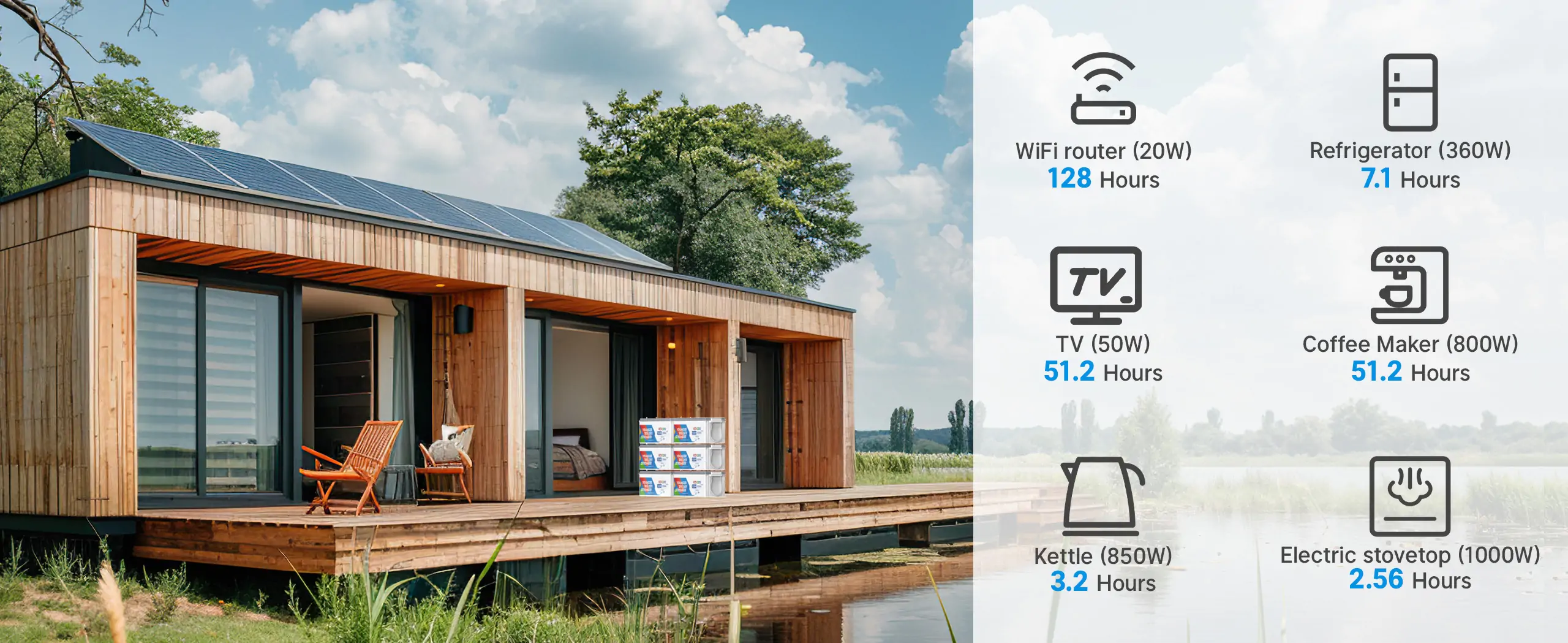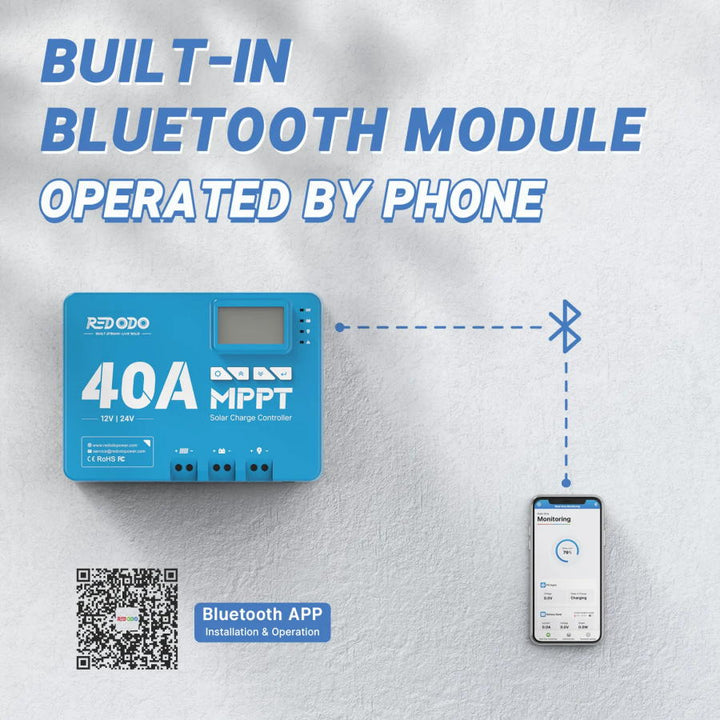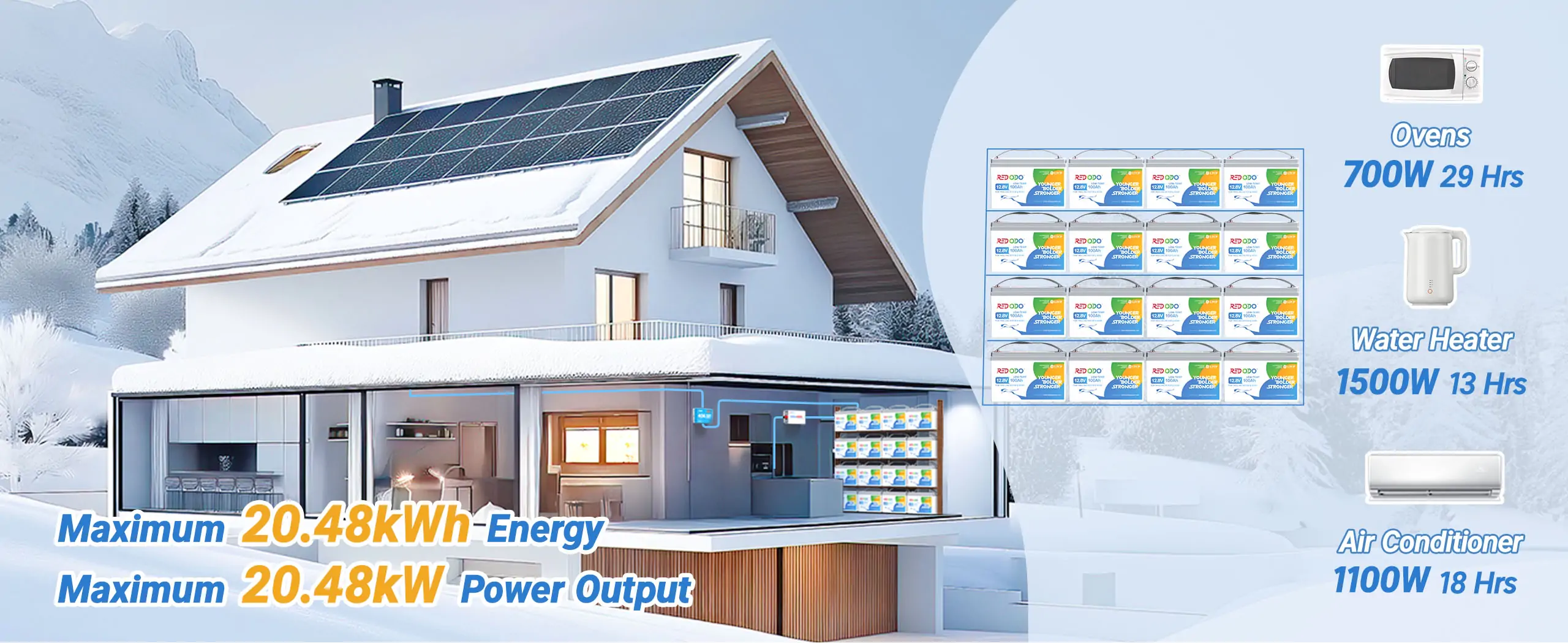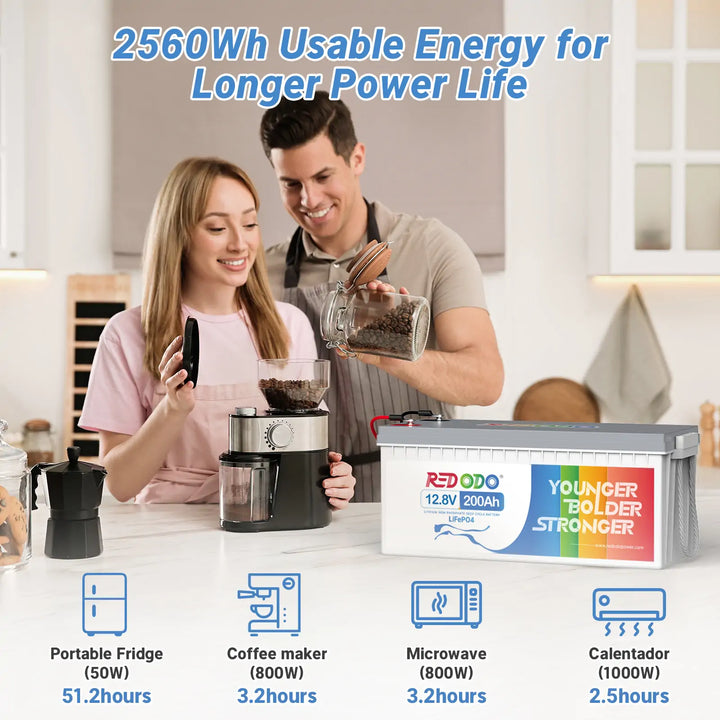When you’re camping in a remote spot, or perhaps you're have a rest in your RV, and you need to charge your phone, lights, or other small devices. A 100-watt solar panel, paired with a 12V battery or a portable power station, is a perfect solution to keep your essentials powered.
But how long will it take for a 100-watt solar panel to charge a 12V battery? In this article, we’ll explore how long it takes, the factors that influence the charging time, and tips of setting up your system for maximum efficiency. Redodo will provide practical insights to help you make the most of your solar energy system.
Table of Content
- How Much Power Will a 100-Watt Solar Panel Produce?
- How Long Will a 100-Watt Solar Panel Take to Charge a 12V Battery?
- Factors that Affect Solar Panel Charging Time
- How to Charge a 12V Battery with a Solar Panel Properly?
- Best Solar Batteries Options for Your 12V Systems
- Get Your Solar Battery from Redodo Today
- Common Questions about Solar Batteries and Panels
How Much Power Will a 100-Watt Solar Panel Produce?
Under ideal conditions, a 100-watt solar panel can produce 100Wh of power per hour of full sunlight. Over the course of a day, assuming 5 hours of full sunlight, the panel can produce approximately 500Wh of energy.
This is based on the assumption that the panel operates at its rated power during peak sunlight hours. In reality, factors like cloud cover, weather conditions, and the angle of the panel can reduce the amount of energy it actually generates. In less sunny areas, or on overcast days, this number can drop significantly.
How Long Will a 100-Watt Solar Panel Take to Charge a 12V Battery?
To give a rough estimate, we assume that the 100Wh solar panel can generate about 500Wh of energy per day (5 hours of full sunlight) and a 12V 100Ah solar battery needs charged.
To fully charge the 12V 100Ah lead-acid battery using a 100W solar panel, you would need 1200Wh of energy. Under ideal conditions with full sunlight, this would take about 12 hours or roughly 2.4 days if sunlight is limited to 5 hours per day.
Here's the calculation:
1,200Wh ÷ 500Wh/day = 2.4 days
2.4 days × 5 hours/day = 12 hours
Similarly, to fully charge a 12V 100Ah LiFePO4 battery, it would take about 12.8 hours or 2.56 days in 5-hours full sunlight.

Factors that Affect Solar Panel Charging Time
Although there is an estimate of the 12V battery charging time with a 100-watt solar panel, there are still many factors that can affect the charging process, and prevent it from reaching ideal efficiency and time, including:
Sunlight Intensity
The amount of sunlight your solar panel receives is the most important factor. Sunlight varies by location, time of year, and weather conditions. Overcast days or shading from trees can significantly reduce the energy your panel generates.
Panel Efficiency
Solar panel efficiency measures how well solar panel is able to convert sunlight into usable electricity. It typically have an efficiency of around 15% to 20%. Over time, as solar panels age, their performance decreases, with a typical efficiency loss of 0.5% to 1% per year.
Dust and dirt accumulation on the surface can block sunlight, reducing energy output. Additionally, temperature impacts panel efficiency with output decreasing by about 0.3%-0.5% for every degree Celsius above 25°C (77°F).
Battery Efficiency
Charging efficiency varies by battery type. LiFePO4 batteries are highly efficient up to 100%, meaning they can store the full energy they receive. In contrast, lead-acid batteries have lower efficiency, usually around 80%. This means you can only convert about 80% of the solar panel's energy into energy stored in a lead-acid battery.
Solar Panel Angle and Orientation
The angle and direction at which your solar panel is positioned can affect how much sunlight it captures. Ideally, it should face directly toward the sun at a 30-45 degree angle to maximize energy production.

How to Charge a 12V Battery with a Solar Panel Properly?
Charging a 12V battery with a solar panel involves a few essential steps to ensure efficiency and safety.
Step 1: Choose the Right Solar Panel and Battery
First, consider LiFePO4 batteries as your solar batteries since they have higher power and longer lifespan. When charging LiFePO4 batteries with solar, make sure the solar panel is matchs the solar charge controller and battery.
For a typical 12V battery, a 100-watt solar panel is often a fit for batteries with a capacity of 100Ah or less. For larger-capacity batteries like 300Ah lithium battery, you may need a larger solar panel or multiple solar panels.
Step 2: Install a Solar Charge Controller
You’ll need to use a solar charge controller that matches the output power and voltage of your solar panel. For a 12V system, ensure that the controller is also rated for 12V and can handle the current your solar panel produces. For example, if you are using a 12V battery with a 100-watt solar panel, a controller rated for 12V will be sufficient to safely regulate the charge.
Step 3: Connect the Solar Charge Controller to the Battery
Now, connect the solar charge controller to your 12V battery and ensure the correct polarity:
- Positive cable from the controller to the positive terminal of the battery.
- Negative cable from the controller to the negative terminal of the battery.
Step 4: Position the Solar Panel Properly
For maximum efficiency, position the solar panel where it will receive the most sunlight. Ideally, the panel should face south in the northern hemisphere and north in the southern hemisphere.
The angle of the panel should be about 30-45 degrees to ensure it captures the most sunlight, especially during peak hours.
Step 5: Connect the Solar Panel to the Solar Charge Controller
After the above steps, connect the solar panel's positive (+) and negative (-) terminals to the corresponding inputs on the solar charge controller.
The positive cable (usually marked red) from the solar panel goes to the positive terminal on the controller, and the negative cable (usually marked black) goes to the negative terminal.
Step 6: Monitor the Charging Process
Once everything is connected, the solar charge controller will begin regulating the voltage and current of the soalr battery. You can monitor the charging progress via controller's display. Using Redodo MPPT solar charge controller with Bluetooth, you can monitor the charging by smartphone directly with ease.
Best Solar Batteries Options for Your 12V Systems
When it comes to powering your solar and off-grid systems, choosing the right battery is crucial. The lithium battery is the perfect choice, offering a budget-friendly yet efficient energy storage solution for solar and off-grid systems.
Redodo specializes in LiFePO4 batteries, offering high-efficiency, long-lasting solutions that are perfect for solar energy storage.
Redodo 12V 100Ah Lithium Solar Battery
The Redodo 12V 100Ah lithium battery is perfect for solar and off-grid systems, offering exceptional performance and longevity. With EV Grade-A cells and over 4000 cycles at 100% DOD, it ensures reliable energy storage for years. Designed for small to medium-sized solar setups, this battery offers fast 5-hour charging and can easily be expanded to larger systems.
Redodo 12V 100Ah Group 31 Bluetooth Lithium Solar Battery
The Redodo 12V 100Ah Group 31 Battery is a smart, high-performance option for solar off-grid. With Bluetooth monitoring, it allows real-time tracking of battery stats through the Redodo App, making it perfect for those who need control over their energy usage. Its upgraded BMS offers 20+ protections, ensuring durability even in harsh environments. With 1280Wh of energy and the ability to expand to 20.48kWh, it’s an ideal choice for solar setups, RVs, sailboats, and off-grid living, delivering efficiency and convenience in a compact Group 31 size.
Redodo 12V 100Ah Group 24 Lithium Solar Battery
Designed to fit the Group 24 size, the Redodo 12V 100Ah Group 24 Battery provides 1.28kWh of energy, making it a perfect replacement for lead-acid batteries in RVs, and camping setups. With 7.5X higher energy density than traditional AGM batteries, this battery offers 4000+ cycles at 100% DOD and a long lifespan of up to 10 years, ensuring reliable performance and reduced maintenance costs. It’s also easily expandable for larger systems, with the ability to support up to 20.48kWh in a 51.2V 400Ah setup.
Redodo 12V 300Ah LiFePO4 Solar Battery
The Redodo 12V 300 amp hour lithium battery offers an impressive 3.84kWh of capacity. With a max load of 2560W, it can power a variety of appliances for extended periods, including keeping your fridge running for over 3 days nonstop. This battery is an excellent replacement for 6 x 12V 100Ah AGM batteries, saving you 65% in space and 300lbs in weight. It also supports fast charging in just 5 hours, and can be expanded to 61.44kWh, perfect for middle to large off-grid setups or solar backup power systems.
Redodo 12V 200Ah Lithium Solar Battery
The Redodo 12V 200Ah LiFePO4 battery offers a substantial 2560Wh of energy and 1280W max load, making it perfect for powering appliances like freezers and fridges off the grid. This battery can replace 4 x 100Ah AGM batteries, saving up to 50% in space and 80% in weight, without extra wiring hassle. It can expand up to 40.96kWh for larger off-grid or solar backup systems. Additionally, with a 10-year lifespan and 4000+ cycles, this battery provides long-term reliability and cost savings for your energy needs.
Get Your Solar Battery from Redodo Today
Redodo focuses on providing high-performance LiFePO4 solar batteries for off-grid systems, RVs, boats, and solar-powered homes. You can count on Redodo to offer the best solution for any solar battery requirement. Shop and find the best for you today!
Common Questions about Solar Batteries and Panels
1. Can a 100 watt solar panel charge a 200Ah battery?
A 100-watt solar panel can technically charge a 200Ah battery, but it will take a long time, especially in non-ideal conditions. Assuming 5 hours of full sunlight per day, the panel could produce around 500Wh per day, while a 12V 200Ah battery stores 2400Wh of energy. Therefore, it would take around 5 days to fully charge the 200Ah battery with a 100W panel, assuming there is no energy draw during the charging process. However, charging time may vary based on factors such as weather, panel efficiency, and energy losses in the system. For faster charging, consider using a larger watt solar panel or multiple panels.
2. How many solar panels can charge a 12V 100Ah battery?
To charge a 12V 100Ah battery, the amount of 100-watt solar panels you need depends on your desired charging time. Ideally, a 100W panel will produce about 500Wh per day. To charge the battery in one day, you'd need about 4-5 panels (based on actual conditions and panel conversion efficiency).
3. Will a 100 watt solar panel charge 2 12-volt batteries?
Yes, a 100-watt solar panel can charge two 12V batteries connected in parallel, as long as the output of solar panel matches your solar charge controller and batteries. However, the charging process will take longer.
Read More:
How Many Solar Batteries Do I Need to Power a House?
How to Charge Marine Trolling Motor Battery With Solar Panel?
Can I Have a Home Battery Backup Without Solar?
The Definitive Guide to LiFePO4 Lithium Battery Voltage Charts

Redodo

Redodo
Recent Post

Convert RV from Lead-Acid to Lithium Battery: A Complete Guide

How Long Will a 200Ah Battery Run an Air Conditioner?

A Full Review of Redodo 12V 140Ah Group 31 Deep Cycle Battery

How Much Does it Cost to Replace Golf Cart Batteries?




![⚡[$239 after Sign-Up] Redodo 12V 100Ah Group 24 Bluetooth LiFePO4 Battery | Real-Time Battery Monitoring | For RV, Marine, Solar](http://www.redodopower.com/cdn/shop/files/Redodo_12V_100Ah_group_24_bluetooth_lithium_battery.jpg?v=1744253032)
![⚡[$220 after Sign-Up] Redodo 12V 100Ah Group 31 Bluetooth Lithium Battery | Real-Time Battery Monitoring | For RV, Marine, Solar](http://www.redodopower.com/cdn/shop/files/redodo_12v_100ah_bluetooth.webp?v=1744698930)
![⚡[$220 after Sign-Up] Redodo 12V 100Ah LiFePO4 Lithium Battery | Best Budget | For RV, Solar, Trolling Motor](http://www.redodopower.com/cdn/shop/files/Redodo_12v_100ah_lithium_battery_b9015ddd-64b5-4be2-8c88-392f0bb4ab30.jpg?v=1742973160)
![⚡[$239 after Sign-Up] Redodo 12V 100Ah Mini Bluetooth LiFePO4 Battery | For RV, Marine, Solar](http://www.redodopower.com/cdn/shop/files/12V100AhMiniSmartLiFePO4LithiumBatterywithBluetooth1.webp?v=1741251007)

![⚡[$294 after Sign-Up] Redodo 12V 140Ah Group 31 Lithium Battery with Bluetooth | 40% More Capacity | For RV, Marine, Solar Home](http://www.redodopower.com/cdn/shop/files/Redodo_12V_140ah_bluetooth_battery_ee6d5fd1-5c7d-4b9a-90ab-d54d06b29a04.jpg?v=1742967763)
![⚡[$377 after Sign-Up] Redodo 12V 200Ah Lithium LiFePO4 Battery | 1280W Load Power | For RV, Solar, Off-Grid](http://www.redodopower.com/cdn/shop/files/Redodo12V200ahlithiumbattery.jpg?v=1735892910)

![⚡[$487 after Sign-Up] Redodo 12V 280Ah Bluetooth Lithium Battery | Low Temp Protection | For RV, Marine, Solar](http://www.redodopower.com/cdn/shop/files/Redodo-12V-280Ah-LiFePO4-Bluetooth-battery.jpg?v=1742812722)
![⚡[$524 after Sign-Up] Redodo 12V 300Ah Lithium LiFePO4 Battery | Replaces 6*12V 100Ah AGM Batteries | RV, Marine, Solar](http://www.redodopower.com/cdn/shop/files/Redodo_12V_300ah_lithium_deep_cycle_battery.png?v=1744797523)
![⚡[$947 after Sign-Up] Redodo 12V 410Ah Lithium LiFePO4 Battery | King of Power | Marine, RV, Solar Home](http://www.redodopower.com/cdn/shop/products/Redodo12V400Ahlithiumbattery-1.jpg?v=1736154087)